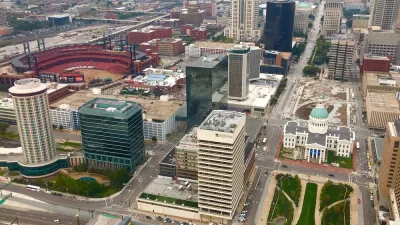It's not the grand slam that the Cardinals and their developer partner were hoping for, but news that the first piece of the $650 million Ballpark Village development project has started construction was welcomed in St. Louis.
With cautious city officials and investors sitting on the sidelines, the St. Louis Cardinals and their developer partner started construction on the $100 million first phase of their ambitious Ballpark Village project, a $650 million mixed-use entertainment-oriented development located adjacent to their downtown stadium, reports Maura Webber Sadovi.
"The developers are hoping to generate interest in the broader project by starting with a smaller piece and adding streets and other infrastructure to make the 10-acre site ready for development. But analysts said financing and the project's completion remain a challenge, as cities and investors more carefully scrutinize entertainment-oriented developments."
"Sports- and entertainment-based facilities have had a really mixed history of success, so investors are becoming pickier about what they do," said Joseph Krist, a municipal-credit analyst with a unit of Swiss bank UBS AG. "Before the financial crisis, there was a greater appetite."
"St. Louis needs the spark that the project may bring," notes Sadovi. "The city's population has dropped more than 50% since 1950 to an estimated 318,000 in 2011, according to the U.S. Census Bureau."
"It's a great start," said Mark Rosentraub, a professor of sports management at the University of Michigan, "They're not just building a stadium and hoping and wishing."
FULL STORY: Cardinals Build a Village

Planetizen Federal Action Tracker
A weekly monitor of how Trump’s orders and actions are impacting planners and planning in America.

Chicago’s Ghost Rails
Just beneath the surface of the modern city lie the remnants of its expansive early 20th-century streetcar system.

San Antonio and Austin are Fusing Into one Massive Megaregion
The region spanning the two central Texas cities is growing fast, posing challenges for local infrastructure and water supplies.

Since Zion's Shuttles Went Electric “The Smog is Gone”
Visitors to Zion National Park can enjoy the canyon via the nation’s first fully electric park shuttle system.

Trump Distributing DOT Safety Funds at 1/10 Rate of Biden
Funds for Safe Streets and other transportation safety and equity programs are being held up by administrative reviews and conflicts with the Trump administration’s priorities.

German Cities Subsidize Taxis for Women Amid Wave of Violence
Free or low-cost taxi rides can help women navigate cities more safely, but critics say the programs don't address the root causes of violence against women.
Urban Design for Planners 1: Software Tools
This six-course series explores essential urban design concepts using open source software and equips planners with the tools they need to participate fully in the urban design process.
Planning for Universal Design
Learn the tools for implementing Universal Design in planning regulations.
planning NEXT
Appalachian Highlands Housing Partners
Mpact (founded as Rail~Volution)
City of Camden Redevelopment Agency
City of Astoria
City of Portland
City of Laramie




























